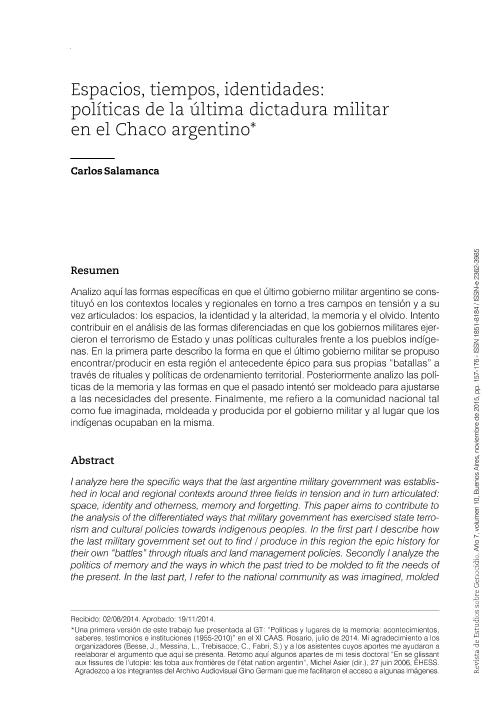Mostrar el registro sencillo del ítem
dc.contributor.author
Salamanca Villamizar, Carlos Arturo

dc.date.available
2019-02-12T22:32:53Z
dc.date.issued
2015-11
dc.identifier.citation
Salamanca Villamizar, Carlos Arturo; Espacios, tiempos, identidades: políticas de la última dictadura militar en el Chaco argentino; Universidad Nacional de Tres de Febrero. Centro de Estudios sobre Genocidio; Revista de Estudios sobre Genocidio; 10; 11-2015; 157-176
dc.identifier.issn
1851-8184
dc.identifier.uri
http://hdl.handle.net/11336/70036
dc.description.abstract
Analizo aquí las formas específicas en que el último gobierno militar argentino se constituyó en los contextos locales y regionales en torno a tres campos en tensión y a su vez articulados: los espacios, la identidad y la alteridad, la memoria y el olvido. Intento contribuir en el análisis de las formas diferenciadas en que los gobiernos militares ejercieron el terrorismo de Estado y unas políticas culturales frente a los pueblos indígenas. En la primera parte describo la forma en que el último gobierno militar se propuso encontrar/producir en esta región el antecedente épico para sus propias “batallas” a través de rituales y políticas de ordenamiento territorial. Posteriormente analizo las políticas de la memoria y las formas en que el pasado intentó ser moldeado para ajustarse a las necesidades del presente. Finalmente, me refiero a la comunidad nacional tal como fue imaginada, moldeada y producida por el gobierno militar y al lugar que los indígenas ocupaban en la misma.
dc.description.abstract
I analyze here the specific ways that the last argentine military government was established in local and regional contexts around three fields in tension and in turn articulated: space, identity and otherness, memory and forgetting. This paper aims to contribute to the analysis of the differentiated ways that military government has exercised state terrorism and cultural policies towards indigenous peoples. In the first part I describe how the last military government set out to find / produce in this region the epic history for their own “battles” through rituals and land management policies. Secondly I analyze the politics of memory and the ways in which the past tried to be molded to fit the needs of the present. In the last part, I refer to the national community as was imagined, molded and produced by the military government, stopping at the ways in which the Indians were challenged by narratives, rituals and interactions with the military authorities.
dc.format
application/pdf
dc.language.iso
spa
dc.publisher
Universidad Nacional de Tres de Febrero. Centro de Estudios sobre Genocidio
dc.rights
info:eu-repo/semantics/openAccess
dc.rights.uri
https://creativecommons.org/licenses/by-nc/2.5/ar/
dc.subject
Espacio
dc.subject
Dictadura
dc.subject
Chaco
dc.subject
Violencia
dc.subject
Qom
dc.title
Espacios, tiempos, identidades: políticas de la última dictadura militar en el Chaco argentino
dc.type
info:eu-repo/semantics/article
dc.type
info:ar-repo/semantics/artículo
dc.type
info:eu-repo/semantics/publishedVersion
dc.date.updated
2019-02-11T13:49:56Z
dc.identifier.eissn
2362-3985
dc.journal.volume
10
dc.journal.pagination
157-176
dc.journal.pais
Argentina

dc.journal.ciudad
Ciudad Autónoma de Buenos Aires
dc.description.fil
Fil: Salamanca Villamizar, Carlos Arturo. Consejo Nacional de Investigaciones Científicas y Técnicas; Argentina
dc.journal.title
Revista de Estudios sobre Genocidio
dc.relation.alternativeid
info:eu-repo/semantics/altIdentifier/url/http://revistagenocidio.com.ar/wp-content/uploads/2017/02/Espacios_Salamanca.pdf
Archivos asociados
